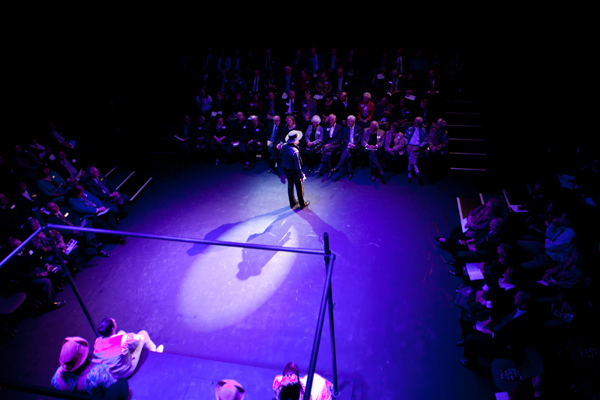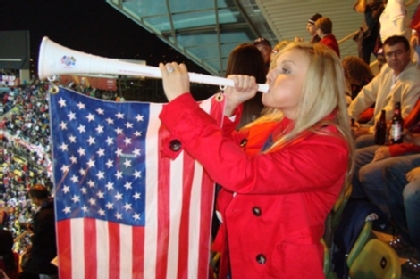Page 62 • (634 results in 0.069 seconds)
-
Who: Jermey Mangan – Graduated from PLU in 1998 with degrees in fine art and German Many SOAC students hope their careers turn out like Jeremy Mangan’s. Currently, he is included in Tacoma Art Museum’s 10th biennial, a group exhibition at Cornish College and a…
in Germany, and the nearly five in New York City. No question growing up in the Pacific Northwest in particular, and the American West in general, have greatly defined my work. I’m fortunate to be extremely fond of the place I’m from. The mountains, waters, trees, and even vast horizons east of the mountains have always been dear to me and important to the work. Other art of any discipline greatly informs my work, as well- whether film, music, other painters… Seeing the contents of so many
-

TACOMA, WASH. (Oct. 11, 2017)- In a lively yet ominous steampunk world, a boy and a bully clash in the classic struggle of good and evil. The stakes: bravery and freedom. The battle: a simple game of marbles. Such is the world depicted in a…
different from footage shot before, requiring the crew to match his hair to earlier footage using hair pieces. The crew also ran into a filming permit issue that left them scrambling to capture some of the final footage: “The last shot of the film where (Jameson’s) on his bike and looks back and smiles,” Petersen said, “we got three takes of that.” The film also received attention from industry leaders in marble production. The marbles used in the film were donated by MegaFun USA, a North American toy
-

TACOMA, WASH. (June 13, 2016)- Kiana Norman ’17 wears a lot of hats. She’s a singer, an actress and a writer. She’s a student, a sister and a daughter. A future world traveler, online journalist and theater critic, if all goes according to plan. But…
prevention PLU Health Center American Psychiatric Association Mental Health America Find a psychologist Other recommended resources NAMI (National Alliance on Mental Illness), PLU chapter“It’s the older and slightly wiser you, four years into the future,” Norman’s column continues. “I’m writing this to hopefully shed some light on how you’re feeling at this moment, and hopefully to help you in your future.” How 19-year-old Norman felt wasn’t great. After her first year of high school was marked by an
-

Nearly a year into his new role as PLU Associate Vice President of Advancement, George Zeno and I took a walk through Parkland and discussed one of my favorite questions, #WhyPLU? Zeno is essentially a community matchmaker for social progress. Mentored at the University of…
institutional mission as a highly dynamic and intentional community partner. What is it about our environment, in particular, that you find energizing? There are few universities in the country that match the diversity of land and people that surround Parkland. We have urban, suburban, shoreline, rural, foothill and Native American communities. We have the fourth largest US military base in the world next door that brings with it the ninth largest veteran community. We are at the center of a rapidly
-
A PLU graduate reflects on his time abroad I sat in one of my first classes at the University of Westminster in London flummoxed. It was days since the terrorist attacks of Sept. 11, and a European student sitting in the back of the lecture…
United States and, to add complexity to an already green and overwhelmed boy, I was transitioning in the aftermath of Sept. 11. That moment effectively served as my principle moment of ¨culture shock¨ during my study away experience at PLU. London led me to Valencia, Spain, following graduation, which led me to a job with the American Red Cross and a volunteer position with the World Affairs Council of Seattle. These experiences eventually guided me to India as a consultant on corporate social
-

Campaign ends, surpasses goal by $22 million A performance in the Studio Theater in Eastvold Hall, which was recently renamed the Karen Hille Phillips Center for the Performing Arts. By Greg Brewis The university’s most recent fundraising campaign was launched amid buoyant economic times, in…
Scholarship for the Women’s Center supports student research and programming at the center. And Lynn (Geschwind ’71) Ostenson, in memory of her late husband Richard Ostenson ’71, established an endowed scholarship for African-American students studying in the natural sciences. Endowment for Academics and Mission Gifts to the campaign led to the creation of four endowed chairs and an endowed professorship. These endowments help attract and retain top faculty, bring public recognition to the university and
-
Originally Published 1999 “The Artist, the thinker, the hero, the saint —who are they, finally, but the finite self radicalized and intensified? . . . The difference between [them] and the rest of us . . . is a willingness to undergo the journey of…
. Finally, my students are free. The asceticism of teaching entails respecting their freedom.While respecting the freedom of my students is prior to all else in teaching humanities, there still is much that I do to invite them into the space where the power of the humanities resides. I introduce them to the field of American religious history in the most engaging way possible, letting them see my own fascination with it. l show them issues; require them to translate material from one frame of reference
-

PLU alum gets a ringside seat to history as U.S. plays in World Cup Last month By Barbara Clements PLU alumna Kelsey (Dawson) Goodson, ’08, accompanied her husband and U.S. soccer player, Clarence Goodson IV, to South Africa to represent the U.S. team at the…
. State Department security marched through the streets into our seats. The typical “uniform” for any given match was a classic American get-up – jeans, tennis shoes, and the jersey of our family member. Face paint with “USA” and the number of our special player were often worn on the cheeks of mothers and (wives)WAGS, but I have to say the men of our group stayed away from anything remotely resembling makeup. As our troop of families made our way into each match, other U.S. fans would cheer us on
-
Barr reflects on her PLU education, work overseas Career diplomat Joyce Barr ’76 spoke to the Class of 2008 and their families during Spring Commencement on May 25 at the Tacoma Dome. The following is the text of her speech: Chair Gomulkiewicz, President Anderson, Provost…
best that people can give. The Foreign Service: Excitement & Enlightenment Since my graduation from PLU, I have spent most of my career working for the Department of State as a Foreign Service Officer. It has been exciting, enlightening and at times enormously difficult but I have found it to be not only extremely satisfying but a lot of fun! The State Department is looking for intelligent, well educated, and highly motivated people like you to promote and protect American interests abroad. The U.S
-

PLU President Allan Belton is a morning person. He’s frequently among the first employees to arrive at the Hauge Administration Building, but not before his morning cup of joe. His favorite coffee stand is on South Tacoma Way, the seven-mile arterial that is the economic…
communities share an origin story. When PLU was established in a forest south of Tacoma 140 years ago, school employees and their families built many of the first houses and businesses in Parkland.As the decades passed, Pierce County’s population boomed, Tacoma’s urban footprint grew beyond the city’s borders, and Parkland transformed from a secluded, predominantly European-American neighborhood to a dense and richly diverse suburban community. PLU students have always been active in the Parkland
Do you have any feedback for us? If so, feel free to use our Feedback Form.


